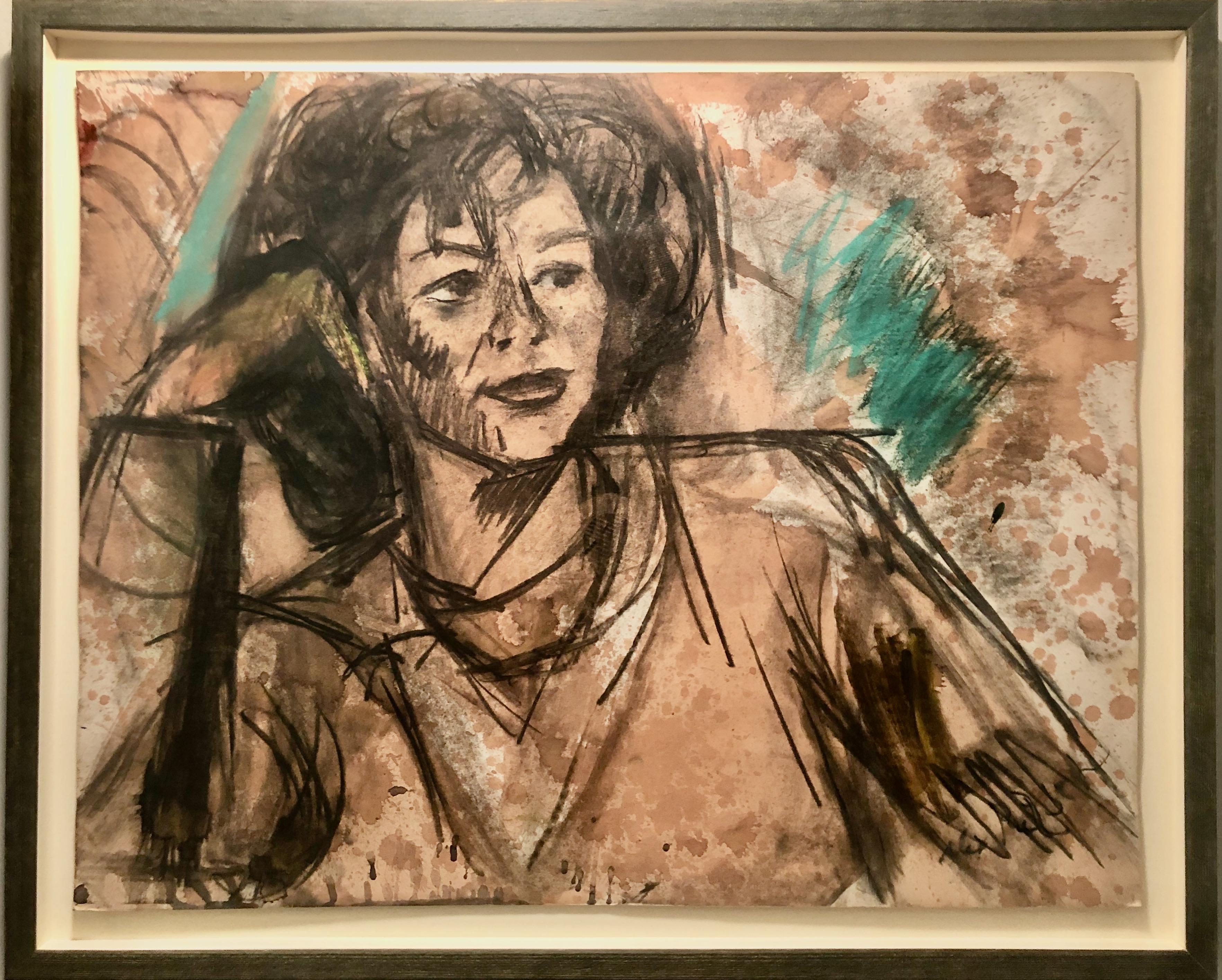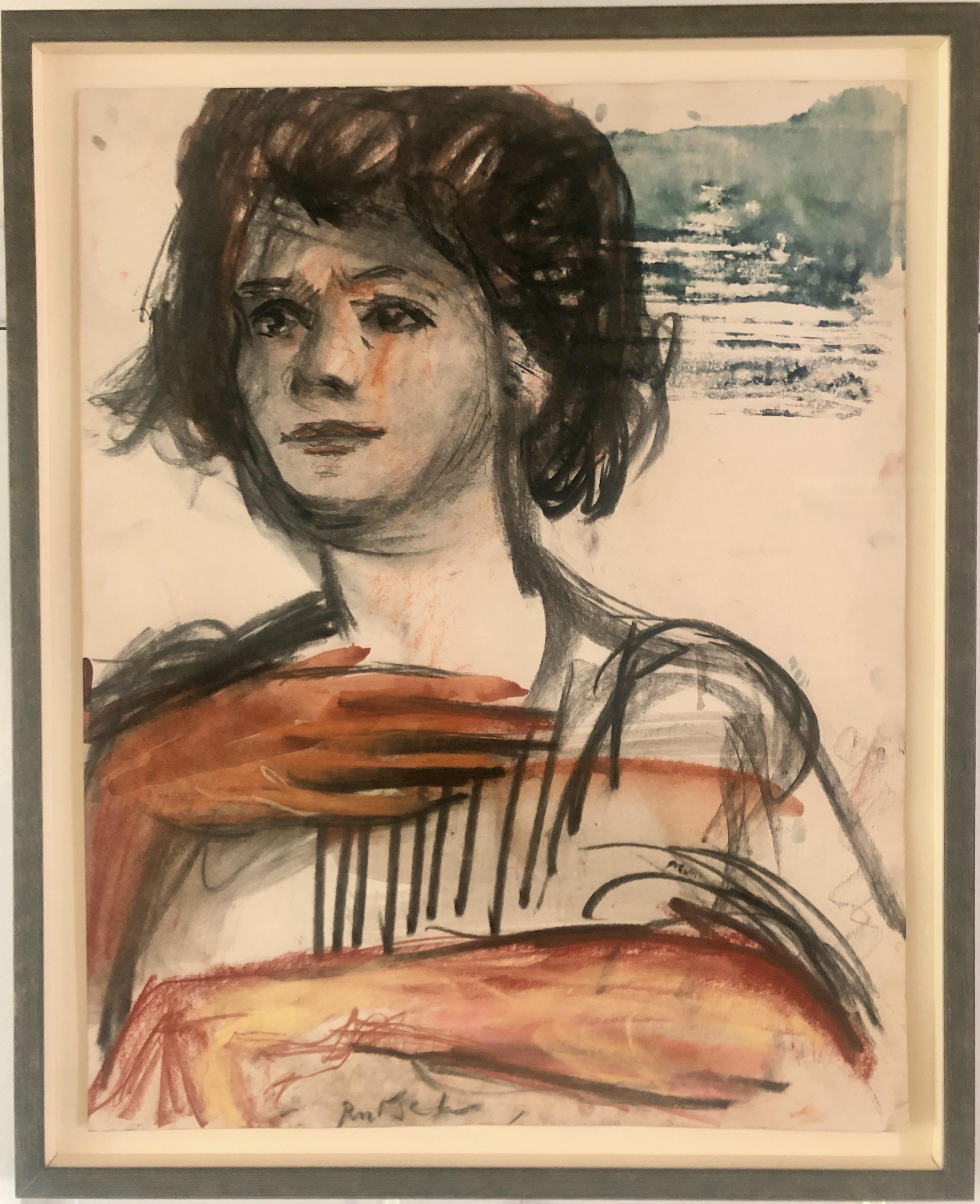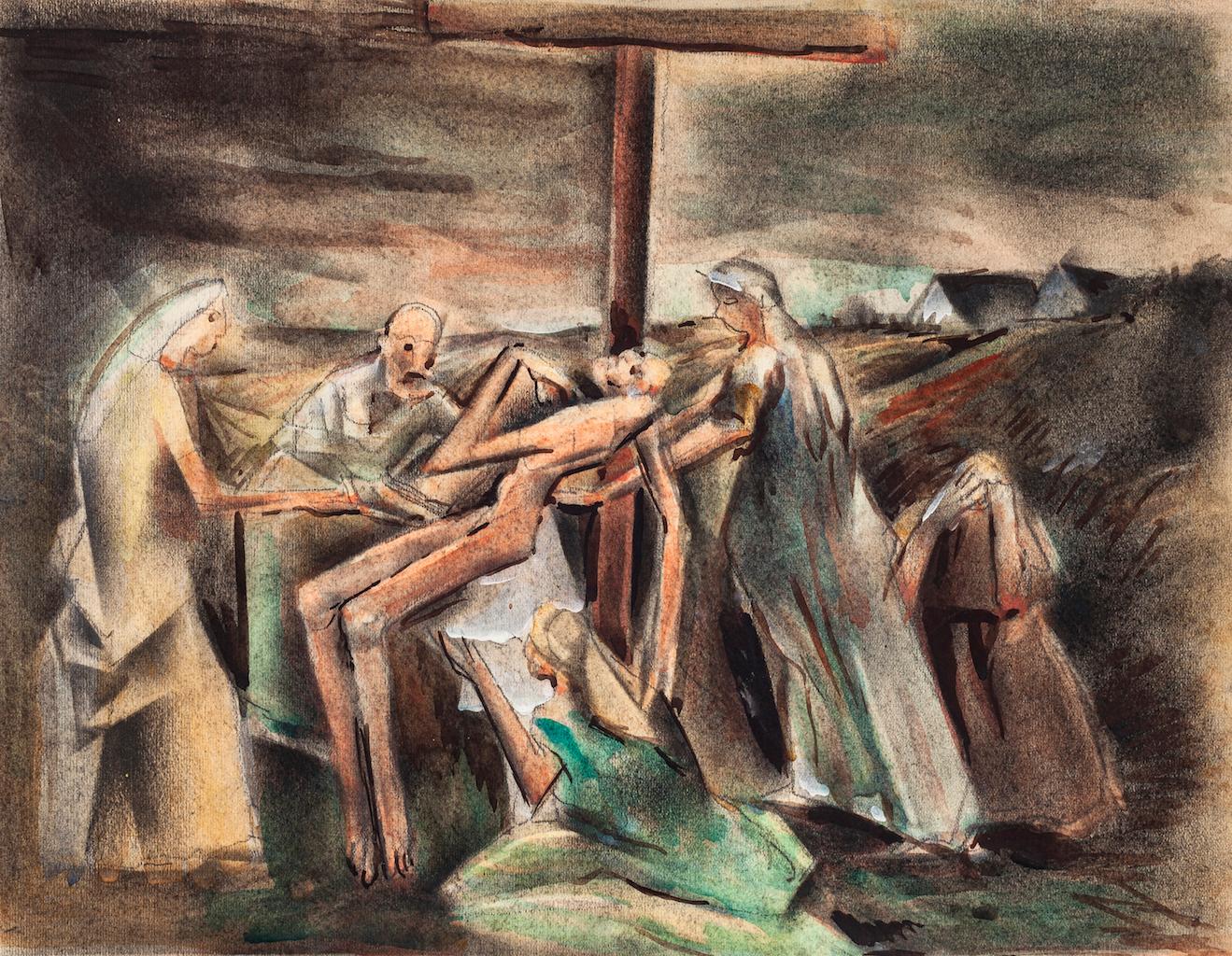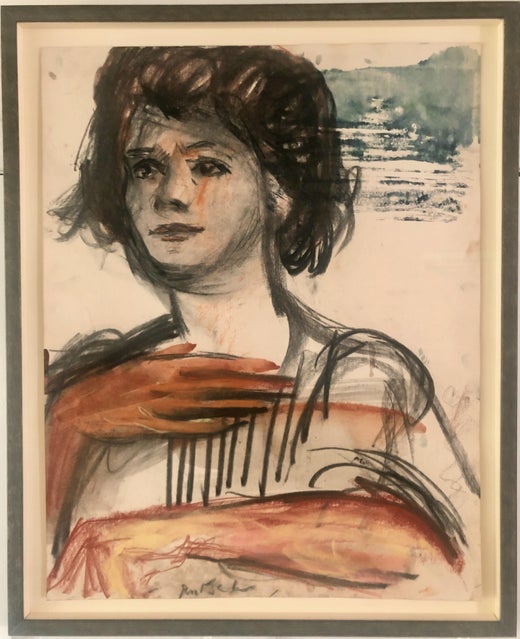Alexander RutschPortrait of A Young Woman Work On Paper
About the Item
- Creator:
- Dimensions:Height: 27 in (68.58 cm)Width: 22 in (55.88 cm)Depth: 1 in (2.54 cm)
- Medium:
- Movement & Style:
- Period:
- Condition:
- Gallery Location:Lake Worth Beach, FL
- Reference Number:1stDibs: LU192211431242
Alexander Rutsch
Alexander Rutsch was born in Russia in 1916 but raised in Belgrade, Yugoslavia. After studying voice in Austria, he became an opera singer like his parents, but after the Second World War, Rutsch's love for visual expression propelled him to change careers. He was a painter, sculptor, philosopher, musician, singer and poet. His life as a romantic is reflected in his work, as he sought to perfect his soul and humanity, "I paint my dreams," said Rutsch. "My dreams are color and life. They soar in my head like millions of symphonies. I can never stop building dreams,” he said. In 1952, after studying under Josef Dobrowsky, Josef Hoffmann and Herbert Boeckl at the Academy of Fine Arts Vienna, Rutsch received a scholarship to study in France. There, he made contacts and began collaborations with his contemporaries, Picasso and Dali. Rutsch said of his experiences with Picasso, "Picasso played a short but important moment in my life in Paris that affected my entire artistic future. I learned from him that it is not important if art is not aesthetically finished. It can be raw, uncooked, rough. If an artist feels he has said it — it is not important to polish or finish it. Because of Picasso, I learned that if I don't feel the need to finish — I don't have to." In 1954, he exhibited his work at the Salon Artistique International de Saceux and won first prize for abstract painting, the first of many awards received during his prolific career. During the 13 years he lived in Paris, Rutsch exhibited in many prominent galleries there and throughout Europe. In 1957, the City of Paris awarded him the prestigious Arts, Science and Letters Silver Medal. In 1968, Rutsch moved to Pelham, New York where he continued to work in his studio and exhibit in galleries and museums worldwide. Rutsch's work, as seen through his mastery of many art forms — sculpture, painting, print-making, and drawing, and a wide variety of other media has been described as "vibrating showers of lines, bold geometries, wounded anatomically rambling scrap-wood skeletons, enigmatic totem figures, and congregations of fetishized, domesticated, and recycled rubbish heaps that conspire to a fantasy of Expressionism, Cubism, Dada, Fauvism, Cobra, and Primitivism." His pieces, as described by Emily Genauer, import silence and the monumentality of primitive statuary. His sculptures are stylized to abstract construction made of found objects welded and reshaped into bronze figures and animals of uncommon wit, airy, with grace and individuality. His portraits are crisp, intense, spare linear characterizations. Rutsch's creations suggest empathy. Rutsch passed away in 1997.
- ShippingRetrieving quote...Ships From: Lake Worth, FL
- Return PolicyA return for this item may be initiated within 3 days of delivery.
- Portrait Of A Young Model Work On PaperBy Alexander RutschLocated in Lake Worth Beach, FLPortrait Of A Young Model Work On Paper Rutsch is always "scribbling and scrabbling." He is an artist of the purest breed—an artist who has no choice but to paint. He is a chosen traveler of the depths of existence; a man who follows a longing to explore his inner self and relate his findings with the energy and identity of the universe. The celebrated Austrian artist approaches painting and sculpture as he lives life—with the eyes of a child and the hand of a poet. Constantly in the quest for rhythms of form and vibrations of color, he catches those "sparks in the shadow" and evidences their fullest reality and beauty in his creations. Each of his paintings is a careful construction as it is a spontaneous act of love. While he might attribute certain artistic expressions to "coincidence," his inspiration comes from such diverse sources as: memories, dreams, sounds, numbers, telephone poles and drift wood. Rutsch has an affinity to vibrant colors, strong contours and rich brush strokes which are apparent in his oils, mixed media works and ink drawings. He has a sensitivity to the unusual, the discarded and a fondness for the ugly as well as the chaotic. These, he often transforms into poignant welded steel abstractions. Rutsch has an aversion to politics, citing dates and expounding upon honors achieved. There is no talk about 'profound symbolism' in his work and as Carlo McCormick writes in the introduction to Rutsch's monograph, "Meaning is not a seed that Rutsch plants, nurtures and then harvests. It is what grows wild in a volcanic swamp of fossilized, decaying and new-born fancies—as an afterthought and aftershock." Alexander Rutsch is not concerned with interpretations; he is, however, passionate about the process of making art and surrenders his entire being as an instrument to the act of creation. The geometry of his imagination overflows with figures, profiles and penetrating strong eyes—windows to a deeper place. Their vitality and sensuality pulsate through the "dreamscapes" of Rutsch's created worlds. At times romantic, yet always wild with energy, human forms and experiences are essential to the artist's vocabulary. The son of opera singers and a singer himself, Rutsch speaks of "the art of painting as the art of silence" and the job of the painter "to dedicate himself to the silence." He adds though, "that this silence is the greatest existing sound in the universe." One wonders why then, if painting is "the art of silence," that Rutsch's paintings scream with sound. Sometimes melancholy, sometimes sensual, sometimes dissonant and sometimes whispering, the rhythms are always rich in the celebration of life and our shared humanity. Painter, sculptor and poet, Rutsch's oeuvre over the past four decades is tremendous. Celebrated and collected especially in Vienna, Paris, Brussels and New York, he studied with renowned teachers like Boeckl and Dorowsky and collaborated with such geniuses as Salvador Dali. Having left Vienna in the fifties, Rutsch moved to Paris and took the city's art scene by storm. There, Picasso was so enthralled with a portrait Rutsch has done of him that, in a state of great excitement, he countersigned it. Biography Alexander Rutsch was born in Russia in 1916 but raised in Belgrade, Yugoslavia. After studying voice in Austria he became an opera singer like his parents, but after WWII, Rutsch's love for visual expression propelled him to change careers. He was a painter, sculptor, philosopher, musician, singer and poet. His life as a romantic is reflected in his work, as he sought to perfect his soul and humanity, "I paint my dreams," said Rutsch. "My dreams are color and life. They soar in my head like millions of symphonies. I can never stop building dreams." In 1952, after studying under Josef Dobrowsky, Josef Hoffmann and Herbert Boeckl at the Vienna Academy of Fine Arts, Alexander Rutsch received a scholarship to study in France. There he made contacts and began collaborations with his contemporaries, Picasso and Dali. Rutsch said of his experiences with Picasso, "Picasso played a short but important moment in my life in Paris that affected my entire artistic future. I learned from him that it is not important if art is not aesthetically finished. It can be raw, uncooked, rough. If an artist feels he has said it—it is not important to polish or finish it. Because of Picasso, I learned that if I don't feel the need to finish—I don't have to." In 1954 he exhibited his work at the Salon Artistique International de Saceux and won first prize for abstract painting, the first of may awards received during his prolific career. During the 13 years he lived in Paris, Rutsch exhibited in many prominent galleries there and throughout Europe. In 1958, The City of Paris awarded him the prestigious Arts, Science and Letters Silver Medal. In 1966, Jean Desvilles presented his prize winning film "Le Monde de Rutsch" at the Cannes Film Festival and the Venice Biennial. In 1968 Rutsch moved to Pelham, New York where he continued to work in his studio and exhibit in galleries and museums worldwide. Rutsch's work, as seen through his mastery of many art forms—sculpture, painting, print-making, and drawing, and a wide variety of other media has been described as "vibrating showers of lines, bold geometries, wounded anatomically rambling scrap-wood skeletons...Category
1980s Expressionist Mixed Media
MaterialsWatercolor, Charcoal, Oil Pastel
- Young Woman Portrait Mixed Media On PaperBy Alexander RutschLocated in Lake Worth Beach, FLYoung Model Expressionist Portrait Rutsch is always "scribbling and scrabbling." He is an artist of the purest breed—an artist who has no choice but to paint. He is a chosen traveler of the depths of existence; a man who follows a longing to explore his inner self and relate his findings with the energy and identity of the universe. The celebrated Austrian artist approaches painting and sculpture as he lives life—with the eyes of a child and the hand of a poet. Constantly in the quest for rhythms of form and vibrations of color, he catches those "sparks in the shadow" and evidences their fullest reality and beauty in his creations. Each of his paintings is a careful construction as it is a spontaneous act of love. While he might attribute certain artistic expressions to "coincidence," his inspiration comes from such diverse sources as: memories, dreams, sounds, numbers, telephone poles and drift wood. Rutsch has an affinity to vibrant colors, strong contours and rich brush strokes which are apparent in his oils, mixed media works and ink drawings. He has a sensitivity to the unusual, the discarded and a fondness for the ugly as well as the chaotic. These, he often transforms into poignant welded steel abstractions. Rutsch has an aversion to politics, citing dates and expounding upon honors achieved. There is no talk about 'profound symbolism' in his work and as Carlo McCormick writes in the introduction to Rutsch's monograph, "Meaning is not a seed that Rutsch plants, nurtures and then harvests. It is what grows wild in a volcanic swamp of fossilized, decaying and new-born fancies—as an afterthought and aftershock." Alexander Rutsch is not concerned with interpretations; he is, however, passionate about the process of making art and surrenders his entire being as an instrument to the act of creation. The geometry of his imagination overflows with figures, profiles and penetrating strong eyes—windows to a deeper place. Their vitality and sensuality pulsate through the "dreamscapes" of Rutsch's created worlds. At times romantic, yet always wild with energy, human forms and experiences are essential to the artist's vocabulary. The son of opera singers and a singer himself, Rutsch speaks of "the art of painting as the art of silence" and the job of the painter "to dedicate himself to the silence." He adds though, "that this silence is the greatest existing sound in the universe." One wonders why then, if painting is "the art of silence," that Rutsch's paintings scream with sound. Sometimes melancholy, sometimes sensual, sometimes dissonant and sometimes whispering, the rhythms are always rich in the celebration of life and our shared humanity. Painter, sculptor and poet, Rutsch's oeuvre over the past four decades is tremendous. Celebrated and collected especially in Vienna, Paris, Brussels and New York, he studied with renowned teachers like Boeckl and Dorowsky and collaborated with such geniuses as Salvador Dali. Having left Vienna in the fifties, Rutsch moved to Paris and took the city's art scene by storm. There, Picasso was so enthralled with a portrait Rutsch has done of him that, in a state of great excitement, he countersigned it. Biography Alexander Rutsch was born in Russia in 1916 but raised in Belgrade, Yugoslavia. After studying voice in Austria he became an opera singer like his parents, but after WWII, Rutsch's love for visual expression propelled him to change careers. He was a painter, sculptor, philosopher, musician, singer and poet. His life as a romantic is reflected in his work, as he sought to perfect his soul and humanity, "I paint my dreams," said Rutsch. "My dreams are color and life. They soar in my head like millions of symphonies. I can never stop building dreams." In 1952, after studying under Josef Dobrowsky, Josef Hoffmann and Herbert Boeckl at the Vienna Academy of Fine Arts, Alexander Rutsch received a scholarship to study in France. There he made contacts and began collaborations with his contemporaries, Picasso and Dali. Rutsch said of his experiences with Picasso, "Picasso played a short but important moment in my life in Paris that affected my entire artistic future. I learned from him that it is not important if art is not aesthetically finished. It can be raw, uncooked, rough. If an artist feels he has said it—it is not important to polish or finish it. Because of Picasso, I learned that if I don't feel the need to finish—I don't have to." In 1954 he exhibited his work at the Salon Artistique International de Saceux and won first prize for abstract painting, the first of may awards received during his prolific career. During the 13 years he lived in Paris, Rutsch exhibited in many prominent galleries there and throughout Europe. In 1958, The City of Paris awarded him the prestigious Arts, Science and Letters Silver Medal. In 1966, Jean Desvilles presented his prize winning film "Le Monde de Rutsch" at the Cannes Film Festival and the Venice Biennial. In 1968 Rutsch moved to Pelham, New York where he continued to work in his studio and exhibit in galleries and museums worldwide. Rutsch's work, as seen through his mastery of many art forms—sculpture, painting, print-making, and drawing, and a wide variety of other media has been described as "vibrating showers of lines, bold geometries, wounded anatomically rambling scrap-wood skeletons...Category
1980s Expressionist Mixed Media
MaterialsCharcoal, Oil Pastel, Watercolor
- Walking By The SeaBy Nicola SimbariLocated in Lake Worth Beach, FLWalking By The Sea. Nicola Simbari was born in Italy and grow up in Rome. He studied at the Accademia di Belle Arti di Roma, and in the 1940s he began devoting himself to painting in a studio at Via del Babuino in central Rome. Simbari's early exposure to the architectural world had a lasting impression on his art, as he incorporated geometric forms and architectural structures into almost all of his paintings. He began to develop a distinct style stemming from impressions of life, nature, and the Mediterranean...Category
1980s Expressionist Abstract Paintings
MaterialsCotton Canvas, Oil
- FightersBy Erwin GuillermoLocated in Lake Worth Beach, FLThe Fighters. Signed and dated lower left, also signed and titled on reverse. Erwin Guillermo was born in Guatemala City in 1951. He is one of the best representatives of Guatemalan Art...Category
1990s Expressionist Figurative Paintings
MaterialsCanvas, Oil
- Still Life With HamLocated in Lake Worth Beach, FLStill Life with ham, oil on canvas signed a wonderful example of the artist's work, from the Collection of Bass Museum Of Art. Canvas size 16 3/4 x 22 1/5 framed 23 x 29. Edmund Pick...Category
1920s Expressionist Still-life Paintings
MaterialsCanvas, Oil
- Edmund Pick Morino Still Life With ChickenLocated in Lake Worth Beach, FLStill Life With Chicken, Oil on canvas singed and dated 1923, from the Collection of Bass Museum Of Art. Canvas size 14 1/5x17 1/4 framed 21 3/8 x 23 7/8 Edmund Pick-Morino was the ...Category
1920s Expressionist Still-life Paintings
MaterialsCanvas, Oil
- Deposition of Christ - Mixed Media on Paper - 20th CenturyLocated in Roma, ITCrucifixion is a modern drawing in mixed media on paper realized by an anonymous artist of the 20 Century. Very good conditions, with a drawing on the rear. The artwork represents ...Category
20th Century Modern Mixed Media
MaterialsMixed Media, Charcoal, Oil Pastel, Watercolor
- Lets PlayLocated in Wareham, GBLets Play is a mixed media painting on archival paper. The work is unframed and would be shipped in a tube. Alternatively for UK customers the work can be framed at Johnsons Picture ...Category
2010s Expressionist Mixed Media
MaterialsOil Pastel, Archival Ink, Acrylic, Archival Paper
- "Underwater love" Collage Mixed Media Woman Figure Painting on Wood Board, 2019Located in Mantova, MNModern, elegant mixed media (oil, oil pastel, pencil, and collage) painting on wood board. Through overlays and transparencies, the contemporary artist Federica Aiello Pini...Category
2010s Expressionist Figurative Paintings
MaterialsPaper, Oil Pastel, Pastel, Oil, Acrylic, Wood Panel, Pencil
- February Figure, female nude, greys earth tonesBy Tom BennettLocated in Brooklyn, NYOil and oil stick over ink on paper. Neutral limited color, expressionist female nude with active brush strokes.Category
2010s Expressionist Nude Paintings
MaterialsPaper, Oil Pastel, Ink, Oil
- The ScreamLocated in Wareham, GBThe Scream is a mixed media painting on archival paper. The work is unframed and would be shipped in a tube. Alternatively for UK customers the work can be ...Category
2010s Expressionist Figurative Paintings
MaterialsOil Pastel, Oil, Acrylic, Archival Paper, Pencil
- Sailors in the Port of NiceBy Alfred SalvignolLocated in London, GB'Sailors in the Port of Nice', mixed media - gouache, pastel and oil on paper, by Alfred Salvignol (circa 1950s). The Port of Nice is one of the key hubs of Nice and, in fact, of the...Category
1950s Expressionist Mixed Media
MaterialsPaper, Pastel, Oil, Gouache





